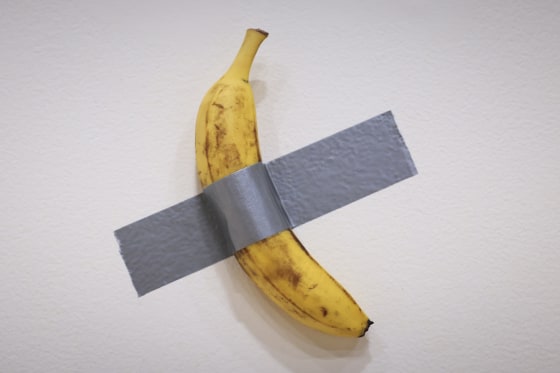
A piece of art that was overtly titled “Comedian” didn’t appeal to the majority of art buyers.
It should come as no surprise that the comedian is merely a banana duct taped to a wall. Maurizio Cattelan, an Italian artist, created the piece, which made a big impression at the 2019 Art Basel fair in Miami but also drew as many laughs as praise from critics.
However, Comedian sold for $6.24 million on Wednesday, including $1 million in fees, giving Cattelan the last laugh.
Justin Sun, a 34-year-old Chinese cryptocurrency platform founder who is headquartered in Switzerland, was quickly identified as the buyer. On his X feed, Sunconfirmed the purchase, stating that it was a cultural phenomena that connects the Bitcoin community, memes, and the realm of art.
I think this work will become part of history and stimulate further reflection and conversation in the future. Sun acknowledged the banana’s significance in both art history and popular culture by writing that he would personally eat it as part of this one-of-a-kind artistic experience.
Meanwhile, a Sotheby’s executive praised the acquisition as representative of someone attempting to answer the most important questions in art.
Sotheby’s head of contemporary art for the Americas, David Galperin, stated in a press statement, “How do you value what, for me at least, is one of the most brilliant ideas in the history of conceptual art?” What better setting than our salesroom to pose that query? Tonight, the answer was a resounding $6.2 million.
However, the majority of the art world shrugged Sun’s winning bid. The purchase of Comedian is unlikely to make a difference, according to Alex Glauber, president of the Association of Professional Art Advisors and founder of AWG Art Advisory, who noted that 2024 has seen some of the poorest sales in decades, continuing a current trend.
Regarding the Comedian sale, Glauber stated, “I don’t think it’s an indication of anything.” He contrasted it with the then-record $450 million purchase of Leonardo da Vinci’s Salvatore Mundifor in 2017, which took place at a time when the market for old masters, or traditional, classic artworks, was declining in favor of modern pieces.
According to Glauber, Comedian is also seen as somewhat of a one-off. Although $6.24 million may seem like a hefty purchase for a sculpture of that caliber, the piece’s ridiculousness is part of its appeal and does not necessarily reflect broader consumer trends.
Glauber referred to artist Marcel Duchamp, whose 1917 submission of a urinal he named Fountain to an art exhibition is regarded as a foundational moment in conceptual art, when he stated that it’s about reflecting the art market while channeling a legacy of conceptual art dating back to Duchamp.
This art is therefore self-reflexive in a sense, and the more it sold for, the more it validated its own theory.
Perhaps a better representation of the art market’s slump can be found in the remainder of Sotheby’s Wednesday auction: The New York Times reports that the Sotheby’s Now segment of the evening, which features artwork created in the past 20 years, brought in $16.5 million in total sales, exceeding projections but falling well short of the $72.9 million received for the 2022 comparable Now auction.
According to a recent study by Jianping Mei and Michael Moses of JP Mei & MA Moses Art Market Consultancy, half of the artwork sold for a loss in the first half of 2024, with an average return of just 0.1%—the lowest yield since 2000.
How awful is it? Moses told NBC News, “It’s as bad as it gets.” This has been a challenging time for the art market.
According to Moses, a major factor is the fact that other investments, such as gold and stocks, have yielded much higher returns this century.
Artworks themselves have their own rates of return that are more dependent on changes in taste than on broader macroeconomic trends, even though some people who have profited from other assets will unavoidably buy art.
As those financial instruments continue to see astounding price increases, Comedian might instead be a sign of an expansion of the kind of items that can be purchased with cryptocurrencies. The price of bitcoin has more than doubled this year and is already close to $100,000.
According to Sotheby’s, Sun, the comedian buyer, made the purchase using his own cryptocurrency, TRX. The market value of all TRX coins that were in circulation at the time of the sale was over $12 billion, according to CoinMarketCap, and Sun had a net worth of $1.5 billion.
The Robb Report claims that the usage of cryptocurrencies in luxury purchases including jewels, yachts, and real estate has grown.
Even still, those purchases might not be typical. People who are newly wealthy due to cryptocurrency price increases seem to be prioritizing financial goals that were previously achievable but have become more challenging after years of skyrocketing consumer prices and high interest rates, according to Robert Allen, a South Florida-based lawyer who specializes in yacht deals.
He claimed that younger generations and millennials no longer have the American dream because of inflation. However, when cryptocurrency gains popularity, some investors utilize it to pay down mortgages or even to travel to Europe or South America. High-end luxury is not going to explode just yet, in my opinion.
Note: Every piece of content is rigorously reviewed by our team of experienced writers and editors to ensure its accuracy. Our writers use credible sources and adhere to strict fact-checking protocols to verify all claims and data before publication. If an error is identified, we promptly correct it and strive for transparency in all updates, feel free to reach out to us via email. We appreciate your trust and support!
